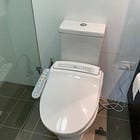Japanese idiosyncrasies and the Galapagos Syndrome pt 1: Toilets
Or the tragic tale and isolation of the Tortoise Toto
For context: Japan is a relatively isolated set of islands off Asia. Likewise, the famous Galapagos islands off the coast of Ecuador is famous specifically for the unusual adaptations of its flora and fauna due to its isolation. These adaptations allowed one Charles Darwin (Chuck), to make observations on how such creatures were only able to survive in isolation. His observations eventually made it into book form and caused a bit of a stir with the Theory of Evolution.
How does this relate to Japan? Well smarter people than me have proposed the concept of the Galapagos Syndrome (ガラパゴス化) to describe the innovations within Japanese society. As a largely self-contained society without interaction with the “mainland” like Chuck’s finches, Japan has been able to develop both consumer goods and a society with elements completely unique to the rest of the outside world.
The distinctive ecosystem of a wealthy society, traditionalist cultural mores, and isolated language has allowed for a phenomenon of Japanese goods that serve only the Japanese populace. Instead of being an importer/exporter, the product is for Japanese people, by Japanese people.
Toilets
The most famous example must be the Japanese toilet. An unreal number of jokes have been made about the everyday item, causing much surprise inside Japan about how and why foreigners seem to be entranced by the device. For the unfamiliar- a Japanese style toilet has a series of buttons and features that make using the bathroom functions more comfortable and clean.
Stranger than the foreign curiosity to this innovation however is the fact no one else seems to want the toilet.
Toto, a famous manufacturer specialising in Japanese toilets, has continually questioned the failure to launch their wildly successful product in countries that aren’t Japan. It should be a simple calculation right? For the general population who use toilets daily, using a nice one that is warm, comfortable and discreet should be a blessing.
Is it the price?
It is an expensive product costing roughly USD$600 per toilet. But the rest of the world seems willing to spend much more for luxury in other facets of life that they use much less frequently. So this shouldn’t rule it out as a common item in more luxurious households. Yet it still a rarity outside of Japan.
Is it a lack of trying to export?
Every few years Toto will make a company announcement in English to promote their newest toilet innovation. Inevitably it is filled with great new features aimed to meet the needs of the global market. Yet just as inevitably, much like Galapagos’ birds, the toilets do not make it much further past outside the protected islands.
The most recent attempt to extend beyond the shores of Japan was the proud announcement from Toto that with the influx of foreign tourists for the 2020 Tokyo Olympics, they would finally have a chance to experience life with a highly functioning toilet. The idea is that they would spread this joy through word of mouth.
Once again this noble attempt to become international went down the drain with foreign tourists unfortunately being barred from the country during the Olympics due to the COVID-19 pandemic.
Do the rest of the world have no need for toilets?
No explanation of Toto’s failed global dominance suffices. Taboos? If any country was to have a shame culture around sanitary products, surely the country’s elements of conservatism would put Japan high up on that list. In fact many of the toilet’s innovations are designed to reduce the ‘shyness’ around the daily business. For example, the option to play music or fake flushing sounds allows for a more civilised and sanitised bathroom trip for all.
The true answer may be the relational nature of Japanese construction that has allowed Toto to thrive. The expectations of every office space, household, or civilised bathroom to include a high tech toilet makes the sales process simple. As the high-tech toilet has become the baseline, it becomes a question of which advanced model. Globally the question is more difficult; does one want to take the risk of leaping from old to new technology, even if it is better, when everyone is happy with the old? Since Toto was able to achieve national success so early, its processes of sales to the wider world is stuck in the assumption that wanting a superior toilet is the default. Toto has adapted so well to working with Japanese construction firms, that it can no longer survive outside despite its many advantages.
So we come back to the Galapagos Syndrome. The exact ecosystem which ensures a product is wildly successful internally also ensures that the same product can’t overcome its internal borders. A problem so aptly named yet so difficult to overcome.
The fear is that this is not a uniquely Japanese or toilet-based phenomenon. Next time I will look at other case studies of Galapagos Syndrome- and how companies can avoid falling into the same pitfalls.
Do you know why Toto keeps failing to globalise the Japanese toilet? Or perhaps you live in a region where Toto has succeeded in breaking through? Comment down below, I’d love to hear.
To later readers of this post, I’ve made a follow up post thanks to comments below linked here!





The problem is real exposure. Let's assume a toilet-goer is highly likely to purchase a nice Toto as long as they have a decent first experience.
Where are they going to have said experience? Traveling? Not many people go to Japan. I suppose this could happen via slow osmosis, but I doubt it. A friend's house? The circle is pretty small. A business? Most likely! However, a lot of businesses are (rightly) skeptical about putting a toilet like that in, because of 1) cost if it breaks 2) making customers uncomfortable because of confusion trying to figure it out 3) difficulty adjusting to what a bidet feels like. Special emphasis on 2. It's not like you can go in there and show every customer; and we all know that customers are idiots and even a very detailed sign explaining will be ignored in horrendous ways.
So we are stuck at the beginning. Practically zero practical exposure leads to practically zero interest. The only way around this is presumably some form of marketing, making it seem exciting enough that a zero-experience consumer will order one. That has its own challenges, the most obvious being: people virtually never replace their toilet unless they have to, and in that case they need a new one fast. And building your own home/planned renovation? Sadly, toilets tend to be very low on the list of decisions to be made. I know this is all broadly true judging by my time working in a hardware store adjacent to the toilet selling area. Add on to that, the fact that most consumers feel like they need a plumber to install one, and plumbers are incredibly expensive? The current situation explains itself.
Hi. Among other jobs, I'm a small-time plumber in the USA.
The biggest problem I see with this device is the need for electrical service to it; if I'm not mistaken, Japan uses a different electrical voltage than the US does (100 volts to the US 110-120), which requires plug adapters for long-term use. Also a new outlet (GFCI) would need to be installed and wired to on a separate circuit from bathroom main power (due to additional "Amp draw" from the 100- 110v adaptation). This raises the expense of installing one in a private home exponentially.
The solution is probably 9v/12v battery power; easy to change and lit only at point of use (maybe a pressure switch on the seat?). Also the device needs to function at a basic level (ie, flush) if the battery/ies are dead. Manual operation alongside would cover that. Some water-supplies would have to be upgraded too; to supply both tank and bidet functions.
Just some thing for you (and Toto) to consider. You got a sub, boss. Nice to meet ya!
-Shags,
Cleveland, OH US